Summary
In view of the problems existing in the conventional cement-soil mixing pile technology, such as uneven distribution of pile body strength, large construction disturbance, and large impact on pile quality by human factors, a new technology of DMP digital micro-perturbation four-axis mixing pile was developed. In this technology, four drill bits can spray slurry and gas at the same time and work with multiple layers of variable-angle cutting blades to cut the soil during the pile formation process. Supplemented by the up-down conversion spraying process, it solves the problem of uneven strength distribution of the pile body, and Can effectively reduce cement consumption. With the help of the gap formed between the special-shaped drill pipe and the soil, the slurry is discharged autonomously, which achieves slight disturbance of the soil around the pile during the construction process. The digital control system realizes the automated construction of pile formation, and can monitor, record and provide early warning for the pile formation process in real time.
Introduction
Cement-soil mixing piles are widely used in the field of engineering construction: such as soil reinforcement and water-proof curtains in foundation pit projects; hole reinforcement in shield tunnels and pipe jacking wells; foundation treatment of weak soil layers; anti-seepage in water conservancy projects walls as well as barriers in landfills and more. At present, as the scale of projects becomes larger and larger, the requirements for the construction efficiency and environmental protection of cement-soil mixing piles have become higher and higher. In addition, in order to meet the increasingly complex environmental protection requirements around the project construction, the construction quality of cement-soil mixing piles must be controlled. And reducing the impact of construction on the surrounding environment has become an urgent need.
The construction of mixing piles mainly uses a mixing drill bit to mix cement and soil in situ to form a pile with a certain strength and anti-seepage performance. Commonly used cement and soil mixing piles include single-axis, double-axis, three-axis and five-axis cement and soil mixing piles. These types of mixing piles also have different spraying and mixing processes.
The single-axis mixing pile has only one drill pipe, the bottom is sprayed, and the mixing is performed through a small number of blades. This is limited by the number of drill pipes and mixing blades, and the work efficiency is relatively low;
The biaxial mixing pile consists of 2 drill pipes, with a separate slurry pipe in the middle for grouting. The two drill pipes do not have the grouting function because the drill bits on both sides need to be repeatedly stirred to make the slurry sprayed from the middle slurry pipe within the plane range. The distribution is uniform, so the "two sprays and three stirs" process are required during the construction of the double shaft, which restricts the construction efficiency of the double shaft, and the uniformity of the pile formation is also relatively poor. The maximum construction depth is about 18 meters [1];
The three-axis mixing pile contains three drill pipes, with grout sprayed on both sides and compressed air sprayed in the middle. This arrangement will cause the strength of the middle pile to be smaller than that of the two sides, and the pile body will have weak links on the plane; in addition, the three-axis mixing pile The water cement used is relatively large, which reduces the strength of the pile body to a certain extent;
The five-axis mixing pile is based on the two-axis and three-axis, adding the number of mixing drill rods to improve work efficiency, and improving the quality of the pile body by increasing the number of mixing blades [2-3]. The process of spraying and mixing is different from the first two. There is no difference.
The disturbance to the surrounding soil during the construction of cement-soil mixing piles is mainly caused by the squeezing and cracking of the soil caused by the stirring of the mixing blades, and the penetration and splitting of the cement slurry [4-5]. Due to the large disturbance caused by the construction of conventional mixing piles, when constructing in sensitive environments such as adjacent municipal facilities and protected buildings, it is usually necessary to use more expensive all-round high-pressure jet grouting (MJS method) or single-axis mixing piles (IMS method) and other micro-structures. Disturbing construction methods.
In addition, during the construction of conventional mixing piles, key construction parameters such as the sinking and lifting speed of the drill pipe and the amount of shotcrete are closely related to the experience of the operators. This also makes it difficult to trace the construction process of the mixing piles and results in differences in the quality of the piles.
In order to solve the problems of conventional cement-soil mixing piles such as uneven pile strength distribution, large construction disturbance, and many human interference factors, the Shanghai engineering community has developed a new digital micro-perturbation four-axis mixing pile technology. This article will introduce in detail the characteristics and engineering application effects of four-axis mixing pile technology in shotcrete mixing technology, construction disturbance control and automated construction.
1、DMP digital micro-perturbation four-axis mixing pile equipment
The DMP-I digital micro-perturbation four-axis mixing pile driver equipment mainly consists of a mixing system, a pile frame system, a gas supply system, an automatic pulping and pulp supply system, and a digital control system to realize automated pile construction.
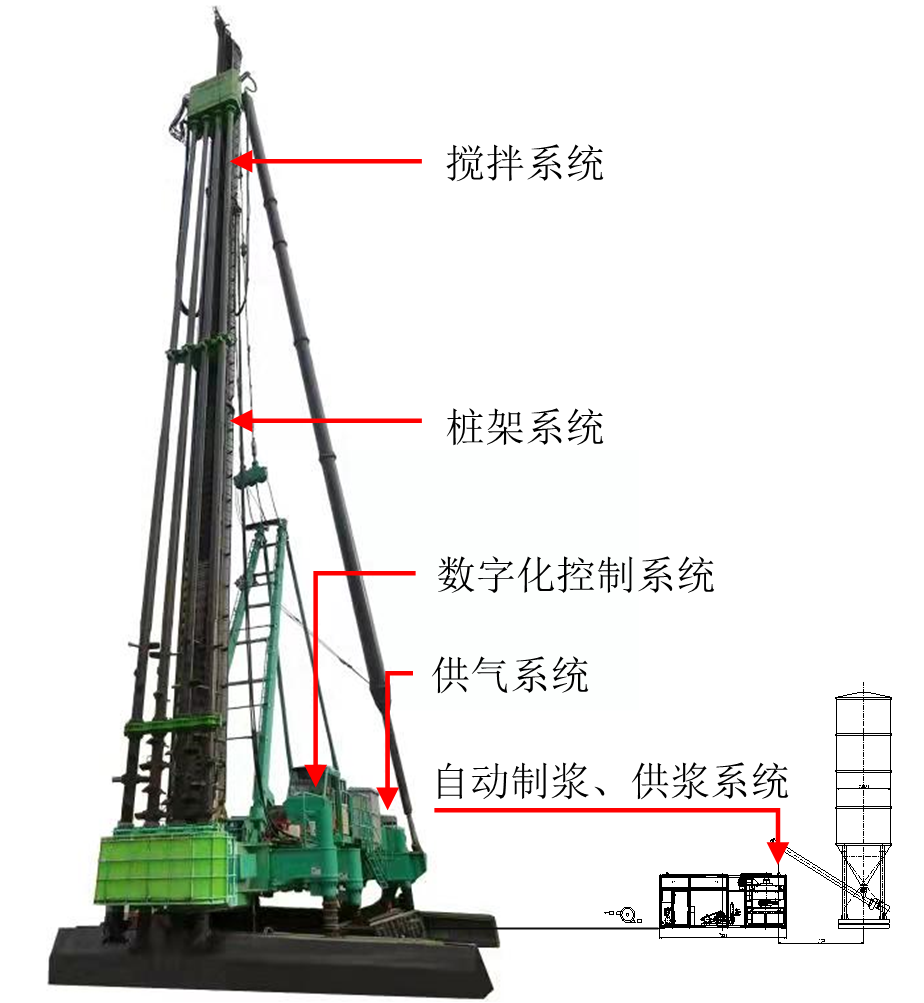
2、Mixing and spraying process
The four drill pipes are equipped with shotcrete pipes and jet pipes inside. As shown in Figure 2, the drill head can spray slurry and compressed air at the same time during the pile forming process, avoiding the problems caused by the spraying of some drill pipes and the spraying of some drill pipes. The problem of uneven distribution of pile strength on the plane; because each drill pipe has the intervention of compressed air, the mixing resistance can be fully reduced, which is helpful for construction in harder soil layers and sandy soil, and can make cement and soil mix. In addition, compressed air can accelerate the carbonation process of cement and soil and improve the early strength of cement and soil in the mixing pile.
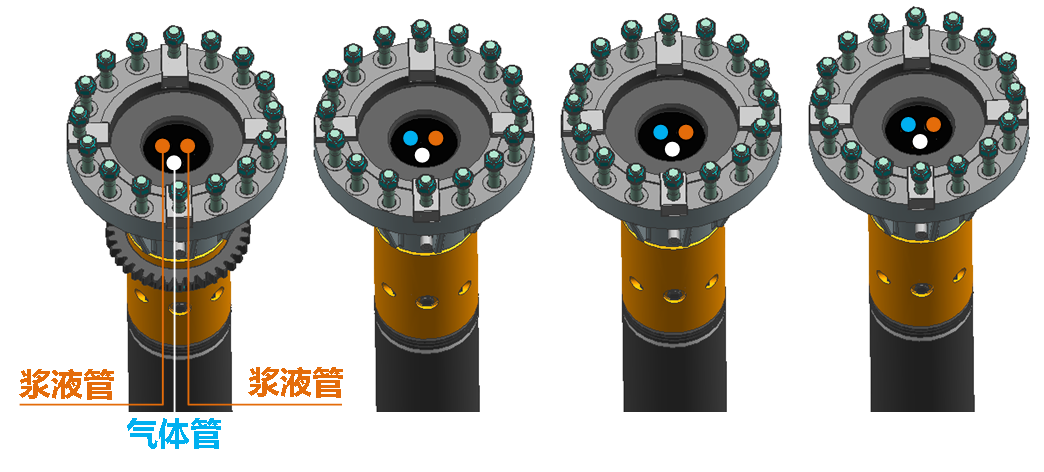
The mixing drill bits of the DMP-I digital micro-perturbation four-axis mixing pile driver are equipped with 7 layers of variable-angle mixing blades. The number of single-point soil mixing can reach 50 times, far exceeding the 20 times recommended by the specification; the mixing drill bit It is equipped with differential blades that do not rotate with the drill pipe during the pile formation process, which can effectively prevent the formation of clay mud balls. This can not only increase the number of soil mixing times, but also prevent the formation of large soil clods during the mixing process, thus ensuring The uniformity of slurry in the soil.
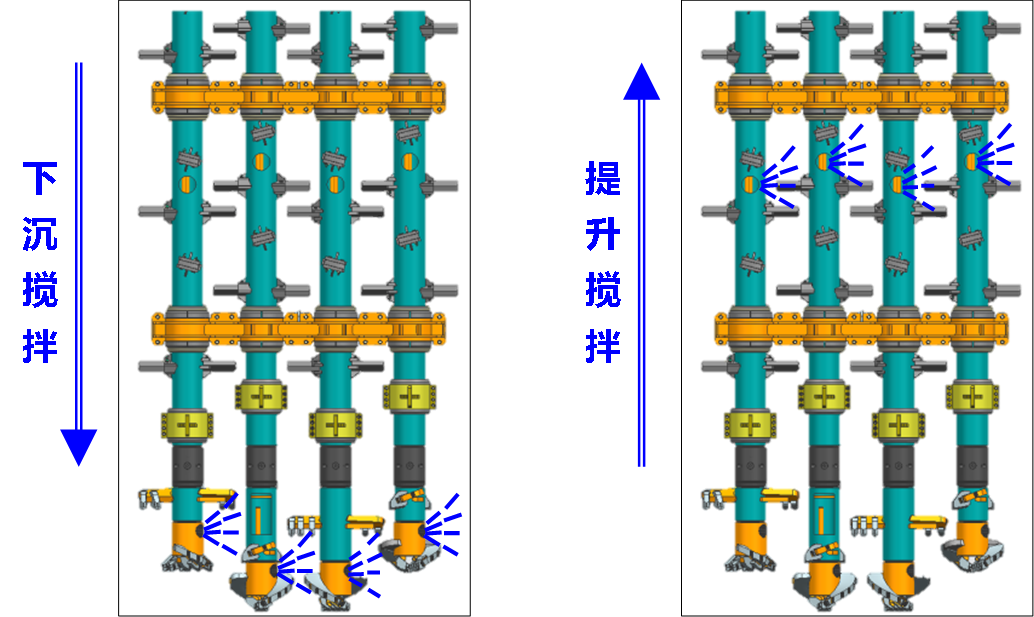
DMP-I digital micro-perturbation four-axis mixing pile adopts up-down conversion shotcrete technology as shown in Figure 3. There are two layers of shotcrete ports on the mixing drill head. When it sinks, the lower shotcrete port is opened. The sprayed slurry is fully mixed with the soil under the action of the upper mixing blade. When it is lifted, the lower shotcrete port is closed and at the same time Open the upper gunite port so that the slurry ejected from the upper gunite port can be fully mixed with the soil under the action of the lower blades. In this way, the slurry and soil can be fully stirred during the whole process of sinking and stirring, which further enhances the uniformity of cement and soil within the depth range of the pile body, and effectively solves the problem of double-axis and three-axis mixing pile technology in the drill pipe lifting process. The problem is that the slurry sprayed from the bottom injection port cannot be fully stirred by the stirring blades.
3、Micro-disturbance construction control
The cross-section of the drill pipe of the DMP-I digital micro-perturbation four-axis mixing pile driver is an oval-like special-shaped shape. When the drill pipe rotates, sinks or lifts, a slurry discharge and exhaust channel will be formed around the drill pipe. When stirring, When the internal pressure of the soil exceeds the in-situ stress, the slurry will be naturally discharged along the slurry discharge channel around the drill pipe, thereby avoiding the squeezing of the soil caused by the accumulation of slurry gas pressure near the mixing drill bit.
The DMP-I digital micro-perturbation four-axis mixing pile driver is equipped with an underground pressure monitoring system on the drill bit, which monitors changes in underground pressure in real time during the entire pile formation process, and ensures that the underground pressure is controlled within a reasonable range by adjusting the slurry gas pressure. At the same time, the configured differential blades can effectively prevent clay from adhering to the drill pipe and the formation of mud balls, and also effectively reduce mixing resistance and soil disturbance.
4、Intelligent construction control
The DMP-I digital micro-perturbation four-axis mixing pile driver equipment is equipped with a digital control system, which can realize automated pile construction, record construction process parameters in real time, and monitor and provide early warning during the pile formation process.
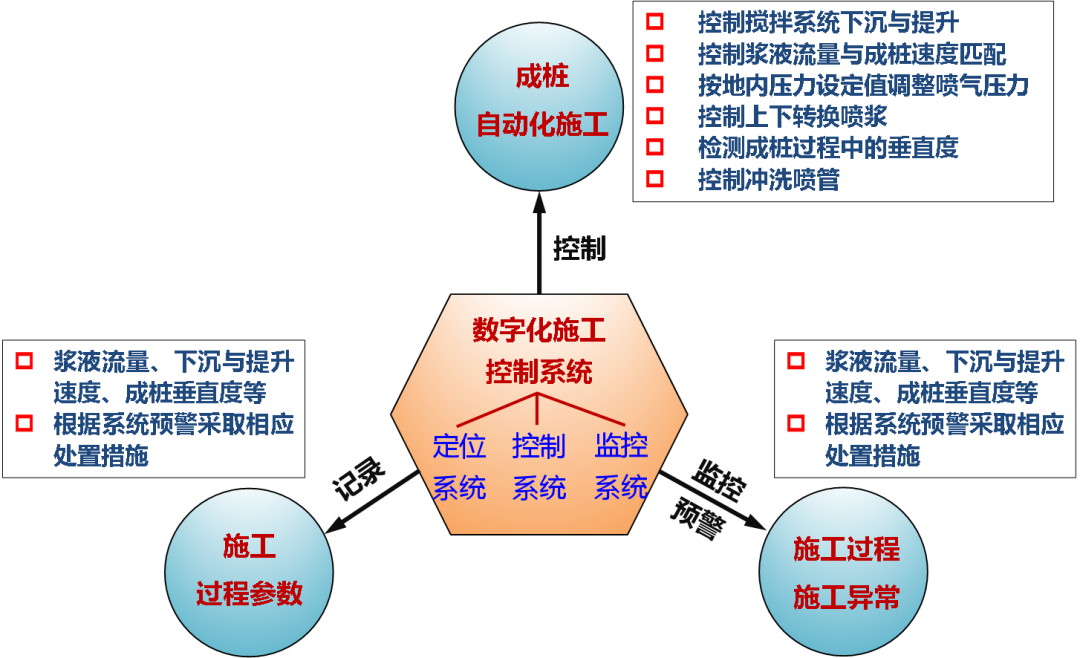
The digital control system can automatically complete the construction of mixing piles based on the construction parameters determined by the trial piles. It can automatically control the sinking and lifting of the mixing system, slurry flow matching and pile formation speed in sections according to the distribution of the vertical soil layer, adjust the jet pressure according to the set value of the ground pressure, and control construction processes such as up and down conversion of spray grouting. This greatly reduces the impact of human factors on the construction quality of the mixing pile during the construction process, and improves the reliability and consistency of the quality of the mixing pile.
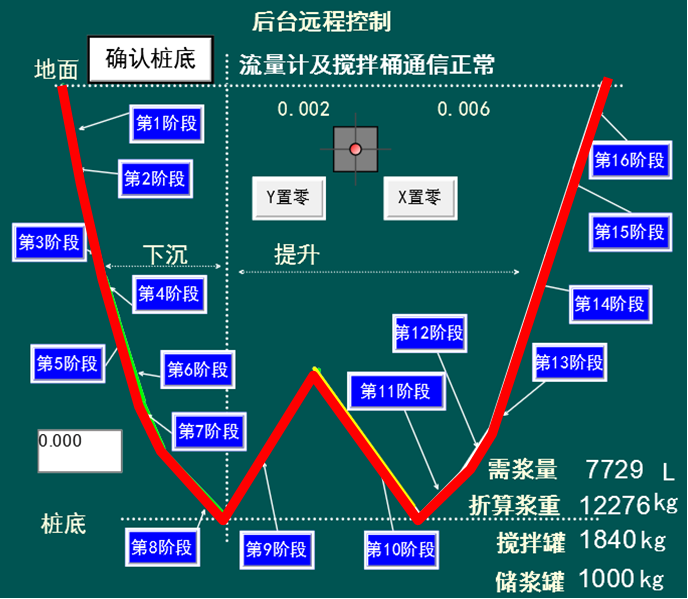
With the help of precision sensors installed on the equipment, the digital control system can monitor key construction parameters such as mixing speed, spraying volume, slurry pressure and flow, and underground pressure, and can provide early warning for abnormal construction conditions, increasing the safety of the mixing pile construction process. Transparency and timeliness of problem resolution. At the same time, the digital control system can record the parameters of the entire construction process and upload the recorded construction parameters to the cloud platform in real time through the network module for easy viewing and inspection, ensuring the authenticity and safety of the data generated during the construction process.
5、Construction technology and parameters
The DMP digital micro-disturbance four-axis mixing pile construction process mainly includes construction preparation, trial pile construction and formal pile construction. According to the construction parameters obtained from the trial pile construction, the digital construction control system realizes the automated construction of the pile. Combined with actual engineering experience, the construction parameters shown in Table 1 can be selected. Different from conventional mixing piles, the water-to-cement ratio used for the four-axis mixing pile is different when sinking and lifting. The water-to-cement ratio used for sinking is 1.0~1.5, while the water-to-cement ratio for lifting is 0.8~1.0. When sinking and stirring, the cement slurry has a larger water-cement ratio, and the slurry has a more sufficient softening effect on the soil, which can effectively reduce the stirring resistance; when lifting, since the soil within the pile body has been mixed, a smaller water-cement ratio can effectively Increase the strength of the pile body.

Using the above-mentioned shotcrete mixing process, the four-axis mixing pile can achieve the same effect as the conventional process with a cement content of 13% to 18%, meeting the engineering requirements for the strength and impermeability of cement-soil mixing piles, and at the same time bringing about changes due to cement The advantage of reducing the dosage is that the replacement soil during the construction process is also reduced accordingly. The inclinometer installed on the drill pipe solves the problem of difficult control of verticality during the construction of conventional cement-soil mixing piles. The measured verticality of the four-axis mixing pile body can reach 1/300.
6、Engineering Applications
In order to further study the pile body strength of the DMP digital micro-perturbation four-axis mixing pile and the impact of the pile-forming process on the surrounding soil, field experiments were carried out in different stratigraphic conditions. The strength of the cement and soil core samples measured on the 21st and 28th days of the collected mixing pile core samples reached 0.8 MPa, which meets the requirements for cement and soil strength in conventional underground engineering.
Compared with traditional cement-soil mixing piles, the commonly used all-round high-pressure jet grouting (MJS method) and micro-disturbance mixing piles (IMS method) can significantly reduce the horizontal displacement of surrounding soil and surface settlement caused by pile construction. . In engineering practice, the above two methods are recognized as micro-disturbance construction techniques and are often used in engineering projects with high requirements for surrounding environmental protection.
Table 2 compares the monitoring data of the surrounding soil and surface deformation caused by the DMP digital micro-perturbation four-axis mixing pile, MJS construction method and IMS construction method during the construction process. During the construction process of the micro-perturbation four-axis mixing pile, at a distance of 2 meters from the pile body The horizontal displacement and vertical uplift of the soil can be controlled to about 5 mm, which is equivalent to the MJS construction method and the IMS construction method, and can achieve minimal disturbance to the soil around the pile during the pile construction process.
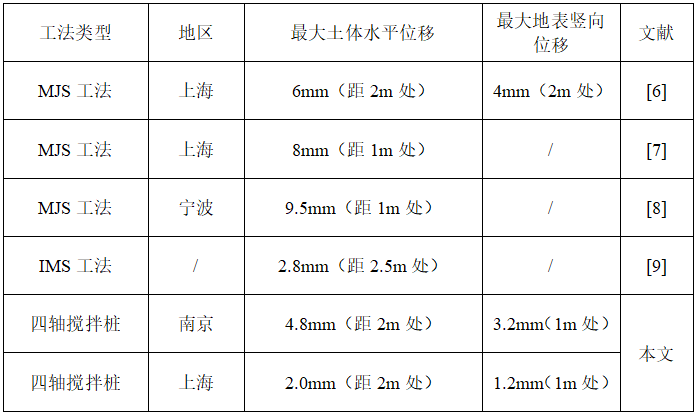
At present, DMP digital micro-disturbance four-axis mixing piles have been successfully used in different types of projects such as foundation reinforcement and foundation pit engineering in Jiangsu, Zhejiang, Shanghai and other places. Combining the research and development and engineering application of four-axis mixing pile technology, the "Technical Standard for Micro-Disturbance Four-axis Mixing Pile" (T/SSCE 0002-2022) (Shanghai Civil Engineering Society Group Standard) was compiled, which includes equipment, design, construction and testing, etc. Specific requirements have been put forward to standardize the application of DMP digital micro-perturbation four-axis mixing pile technology.
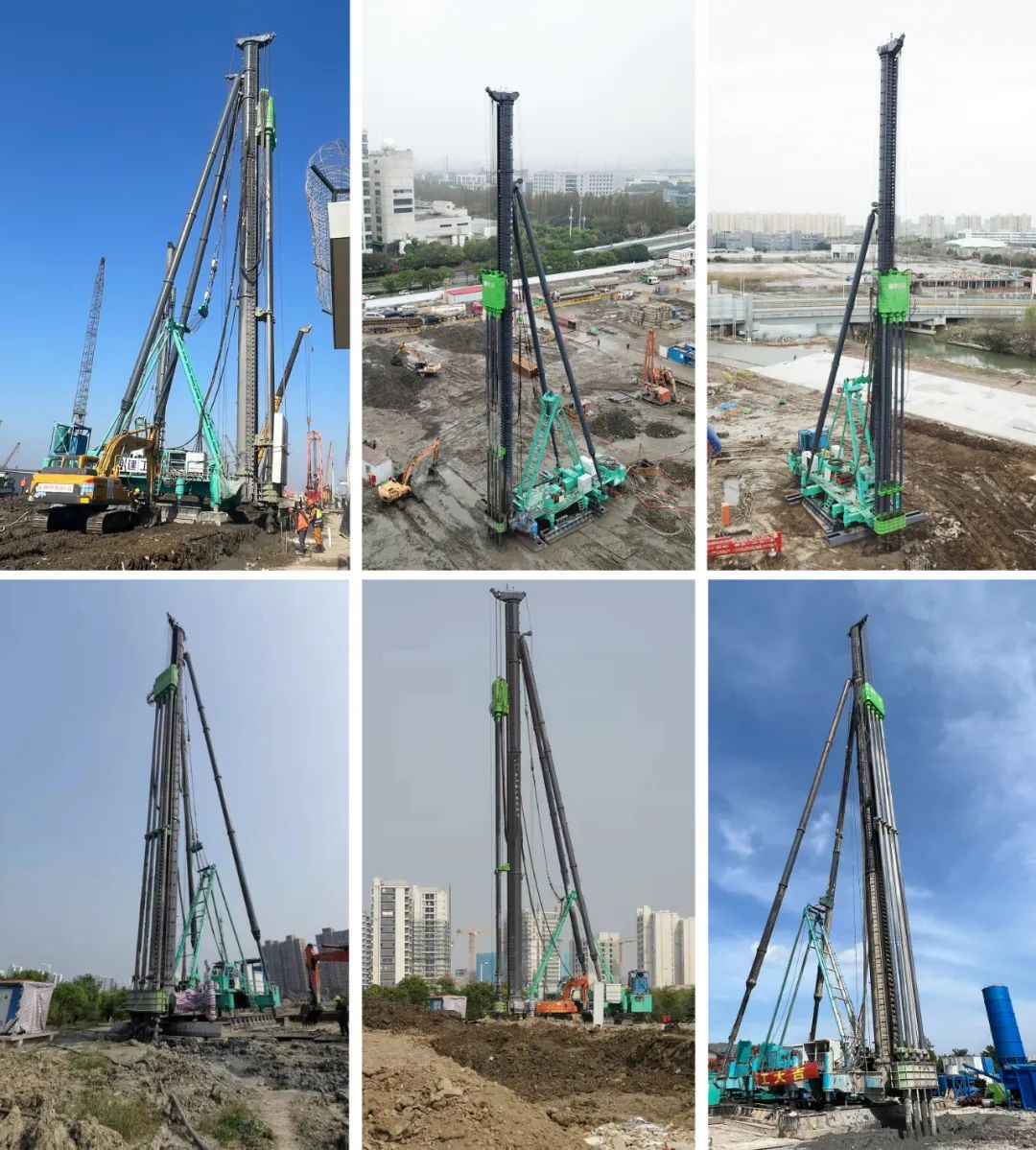
Post time: Sep-22-2023

 한국어
한국어